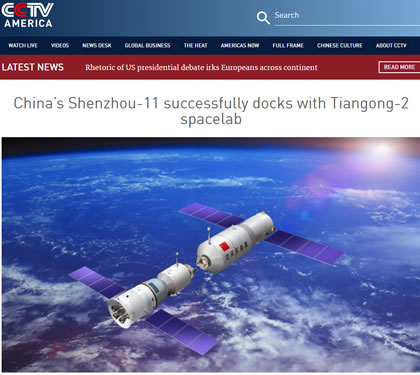PRESS RELEASE
China’s Space White Paper Outlines Next Five Years’ Activities for Manned Exploration, Space Science, and International Cooperation
December 2016
 Click here for full coverage in English, with videos, on CCTV America. |
Dec. 27, 2016 (EIRNS)—Today China released its stunning five-year plan for space, titled, "China’s Space Activities in 2016" in a white paper in Beijing. The White Paper’s stated purpose is, "to enable the world community to better understand China’s space industry," and to "offer a brief introduction" to its major accomplishments since 2011. The Preamble explains, "[T]he Chinese government takes the space industry as an important part of the nation’s overall development strategy." The purpose of China’s space program, the Preamble states, is "to contribute more to both serving national development and improving the well-being of mankind."
The bulk of the paper summarizes the achievements of China’s manned, lunar, Earth orbital, and international cooperation programs, and outlines the tasks for the next five years. These re-state the first launch of the unmanned Tianzhou cargo carrier; the launch of the first element of the space station; the two lunar missions over the next two years, and China’s first Mars mission, in 2020. As is customary, at a press conference releasing the paper, the question of a manned lunar mission was raised, and as has been the response, it was stated that this has not yet been approved by the government.
Certain details are presented about lunar work. The lunar probe to be launched in 2018 is to achieve the world’s first soft landing on the far side of the moon. In China’s lunar exploration project, it will strive to attain automated extra-terrestrial sampling, and technology for handling and return, by the space explorers. The White Paper said, "The lunar probe Chang’e-4 will conduct in situ and roving detection and relay communications at earth-moon L2 point."
The White Paper’s section on international cooperation summarizes the 29 countries and organizations with which China has space cooperation agreements. Most interesting, under the sub-headline of "Key Areas for Future Cooperation," it lists, "Construction of the Belt and Road Initiative Space Information Corridor," for Earth observation, communications, navigation, and other applications. It also lists "Construction of the BRICS remote-sensing satellite constellation."
China also announced that it has opened up nearly all areas of its space industry for private and international "investment." It was stated that there will be "very few off-limits areas." China’s space station will be a major area for such cooperative investment.
The White Paper concludes:
"It is mankind’s unremitting pursuit to peacefully explore and utilize outer space. Standing at a new historical starting line, China is determined to quicken the pace of developing its space industry and actively carry out international space exchanges and cooperation, so that achievements in space activities will serve and improve the well-being of mankind in a wider scope..."
